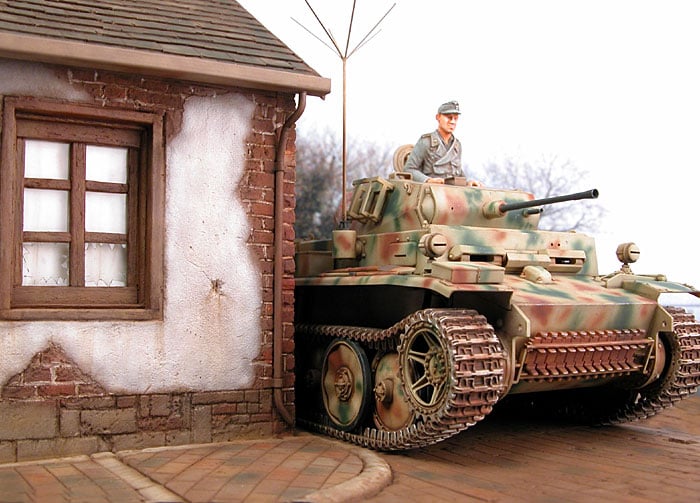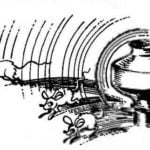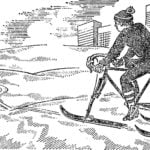 At the initial stage of the Second world war, tasks of intelligence in the interest of armored and motorized units of the Wehrmacht did pretty well armored. Their use in this role was promoted as an extensive road network of Western Europe, and the absence of the enemy’s massive anti-tank defense (PTI).
At the initial stage of the Second world war, tasks of intelligence in the interest of armored and motorized units of the Wehrmacht did pretty well armored. Their use in this role was promoted as an extensive road network of Western Europe, and the absence of the enemy’s massive anti-tank defense (PTI).
After the German attack on the Soviet Union the situation has changed. In Russia, as we know, there are no roads, only directions. With the autumn rains German armored car reconnaissance hopelessly stuck in the Russian mud ceased to cope with its tasks. In addition, the situation is exacerbated by the fact that at about this time in the infantry units of the red Army in increasing numbers began to receive anti-tank rifle (PTR), which give the anti-tank defense massive character. In any case, the German General von Mellenthin noted in his memoirs: “the Russian infantry has good weapons, especially many anti-tank weapons: sometimes I think that every infantryman has anti-tank rifle or anti-tank gun”. Released from the PTR armor-piercing bullets of caliber 14.5 mm, easily pierced the armor of any German armored cars — both light and heavy.
In order to improve the situation, the reconnaissance battalions began to pass half-track armoured personnel carriers Sd.Kfz.250 and Sd.Kfz.251, and also to be used for this purpose, light tanks Pz.ll and Pz.38(t). However, the need for special reconnaissance tank became apparent. However, experts of the office of arms of the Wehrmacht foresaw this development and initiated the work on the eve of the Second world war.
In the summer of 1938 MAN and Daimler-Benz began designing reconnaissance tank, which received the designation VK 901. Formally, it was considered the development of the tank Pz.ll, but in fact was a completely new design. The same pair were only the thickness of the armor plates and weapons — 20-mm gun KwK 38. Chassis with so-called “checkerboard” arrangement of rollers was developed by engineer Wilhelm Clipcanvas and consisted of five road wheels on Board. In the power compartment housed the engine Maybach HL45 150 HP (109 kW), accelerates a fighting machine weight 10.5 t up to maximum speed on the highway at 50 km/h.
The prototype was manufactured in 1939. After the end of the polygon and military trials planned to begin production of the “zero” series of 75 cars, which assigned the designation Pz.ll Ausf.G. However, from April 1941 to February 1942 produced only 12 tanks of this type.
In 1940 work began on a modernized version of the Pz.ll Ausf.G — VK 903. The car has received the engine Maybach HL 66р power of 200 HP and gearbox ZF Aphon SSG48. The maximum speed reached 60 km/h, which for reconnaissance vehicles is more than enough. In 1942 was created the version of this tank with a tower that had no roof, which facilitated surveillance in intelligence. This modification received the designation VK 1301 (VK 903b).

Reconnaissance tank “Lohse”:
1 — 20-mm gun KwK 38; 2 — side viewing device of the driver; 3 — antenna radio Fspr “f”; 4 — antenna radio FuG 12; 5 — a steering wheel; 6 — support roller; 7 — driving wheel; 8 — telescopic shock absorber; 9 — radio operator hatch; 10 — driver’s hatch; 11— Luc charging; 12 — hatch commander; 13 — the hatch for start-up flares; 14 — armored glass antenna input; 15 — instrument observations of an operator; 16 — surveillance device of the driver; 17 — lights with svetamaksimova nozzle; 18 — the aft hatch tower; 19 — damper; 20 — exhaust pipe; 21 — coaxial machine gun MG 34
The program of development of tank troops of the Wehrmacht “Panzerprogramm 1941”, approved April 30, 1941, provided for a truly fantastic production volumes reconnaissance tank VK 903: 10 950 machines supposed to make a reconnaissance variant, 2738 — as ACS with 50-mm cannon, and 481 — to 150-mm howitzer sIG 33. Tanks VK 903 and VK 1301 received army designation Pz.ll Ausf.H and M, respectively, but their production was not maximized.
Control arms come to the conclusion that the development of a new reconnaissance tank design which would take into account the experience of the first years of the war. And this experience is required to increase the number of crew members, a larger capacity engine, radio station with a large radius of action, etc.
In April 1942, the firm MAN produced the first prototype tank VK 1303 weighing 12.9 per T. In June, he was tested at Kummersdorf polygon together with developed on a similar specification tanks Pz.38(f) of the company TIM and T-15 firm Skoda. During testing, the VK 1303 has passed 2484 km this engine and the main clutch worked perfectly.
Tank VK 1303 was adopted by the panzerwaffe under the designation Pz.ll Ausf.L Luchs (Sd.Kfz.123). Production order the firm MAN made 800 combat vehicles of this type.
Luchs (“Lohse” — lynx) was armored somewhat better than its predecessor VK 901, but the maximum thickness of the armor also did not exceed 30 mm, which was insufficient. Welded body with box shape divided into three compartments: a control (it is the same gear), military and motor. In the front of the hull on the left is driver, right — the radio operator. Available in both front hull had monitoring devices, lockable sliding armor flaps and peepholes in the sides. The turret housed the commander (aka gunner) and loader.
Welded tower was the size of a large than of all previous models of reconnaissance tanks, but in contrast to the VK 901 and VK 903 a commander’s cupola with “Lohse” was absent. On the roof of the tower there were two periscope surveillance device: one in the lid of the commander’s hatch, the other in the hatch loader. In a last — observation instrument and in the right side of the tower. In contrast, all modifications of linear Pz.ll, the tower of “Lohse” was located symmetrically relative to the longitudinal axis of the tank. Rotate the tower manually.
The tank’s armament consisted of 20-mm gun Rheinmetall-Borsig KwK 38 with a barrel length of 112 gauge (2140 mm) and coaxial 7.92-mm machine gun MG 34 (MG 42). The rate of gun — 220 RDS./min, the initial velocity armor — piercing projectile- 830 m/s. armor-Piercing shell penetrated the 25-mm armor plate placed at an angle of 30°, with a distance of 350 m. a gunner to fire out of a cannon single-lens had a telescopic sight Zeiss TZF 6/38 with a 2.5-fold increase. The same sight could be used for firing the machine gun. The latter, moreover, was equipped with the regular sight KgzF 2. The ammunition consisted of 330 rounds and 2250 rounds. Vertical guidance coupled installation was possible in the range from -9° to +18°. On the sides of the tower were installed in three mortice NbK 39 to start the smoke grenade caliber of 90 mm.

VK 1602 Leopard
In the design of “Lohse” it became clear that too weak for 1942 20-mm gun can significantly limit the tactical capabilities of the tank. So from April 1943 was supposed to begin production of combat vehicles armed with 50-mm cannon KwK 39 with a barrel length of 60 calibres. The same gun was mounted on medium tank Pz.lll modifications J, L and M. However, to place the instrument in the staff tower of “Lohse” is not possible — for him, it was too small. Besides sharply reduced the ammunition. In the end, the tank has established an open top of a larger tower size, in which 50-mm gun was a great addition. A prototype of such a tower has received the designation VK 1303b.
The tank was installed 6-cylinder petrol four-stroke inline liquid-cooled engine Maybach HL 66р capacity of 180 HP (132 kW) at 3200 rpm and a working volume 6754 cm3. The cylinder diameter is 105 mm. Stroke 130 mm. compression ratio of 6.5.
The motor starts the electric starter Bosch GTLN 600/12-12000 A-4. It was possible and manual start. Fuel — leaded petrol with octane number 76 — was placed in two tanks with a total capacity of 235 L. his Flow forced by a pump Pallas Nr 62601. Carburetors two brand Solex 40 JFF II. (One serial tank Pz.ll Ausf.L in the experimental procedure was equipped with a 12-Chi-lindrum V-shaped diesel engine Tatra 103 with 220 HP).
The drivetrain consisted of a two-disc main clutch dry friction type Fichtel & Sachs “Mezapa”, mechanical synchronized gearbox ZF Aphon SSG48 (6+1), driveshaft and brakes MAN.
To the chassis of the tank “Lohse” in relation to the one side consisted of five rubber road wheels diameter 735 mm each, arranged in two rows; a front drive wheel arrangement with two removable gear (23 teeth) crowns; guide wheel with the tensioning mechanism of caterpillars. On the first and fifth support rollers mounted hydraulic telescopic shock absorbers. Caterpillar melkosofta, dvuhgnezdnaja a width of 360 mm.
“Lohse” was equipped with VHF radio FuG 12 and shortwave radio Fspr “f”.
Mass production reconnaissance tanks of this type was started in the second half of August 1942. Until January 1944, the firm MAN has released 118 “lohav”, the company Henschel — 18. All these tanks were armed with 20-mm cannon KwK 38. As for the fighting machines with 50-mm cannon, to specify the precise number is not possible. According to various sources the factory shop left from four to six tanks.
The first production “Lohse” began to enter the army in the fall of 1942. They were supposed to equip one company in the reconnaissance battalions of armored divisions. However, due to the small number of cars produced, new tanks got very few connections panzerwaffe. On the Eastern front it was the 3rd and 4th Panzer divisions in the West — 2-I-116-I Training tank division. In addition, several cars were in service of the SS tank division “Dead head”. In these compounds “Lohse” was used until the end of 1944. During combat use revealed the weakness of the arms and armor of the tank. In some cases, its frontal armor reinforced with additional armor plates of thickness 20 mm. it is known that a similar event was carried out in the 4 th reconnaissance battalion 4 th Panzer division.
To the present day preserved two copies of the light tank Pz.ll Ausf.L “Lohse”. One is in the UK, in the Museum of the Royal tank corps at Bovington, the other in France, in the tank Museum in Samurai.
In the design of mass reconnaissance tank company MIAG and Daimler-Benz received an order to develop a new combat vehicle, received index VK 1602 and the name “Leopard” and is intended for so-called reconnaissance.

Tank VK 1602 was a development of the experimental VK 1601, made in 1940. The latter was conceived as a machine infantry support and had a very powerful for a light tank reservation from 50 to 80 mm. Structurally, it was similar to other experienced cars of that period — the VK 901 and VK 903 and had a similar armament. VK 1601 received the army index Pz.ll Ausf.J. Seven of these machines passed military tests in the 12th Panzer division on the Eastern front.
However, from its predecessor “Leopard” borrowed except that the thickness of the armor plates, the rest it was a completely new combat vehicle, which is sometimes called “Little Panther”.
Book tower “Leopard” was 50-80 mm, case — 20— 60 mm Combat weight increased to 26 t dimensions reached 6450 mm in length, 3270 and 2800 mm in width and height, respectively. Carburetor HL 157 engine power of 550 HP (404 kW) clocked “Leopard” to a maximum speed of 50 km/h (according to other sources — 60 km/h). The feature of the machine — aft transmission, unusual for a German tank. Welded the tower in a streamlined shape, was mounted 50-mm cannon KwK 39 with a barrel length of 60 calibres and coaxial machine gun MG 42 caliber 7.92 mm Gun was provided with two-chamber muzzle brake. The characteristic external features of the tank was a commander’s cupola and mask gun cast type Saukopf — “pig’s snout”. Chassis “Leopard” consisted of six road wheels on Board, staggered. Tracks width — 350 mm. the Crew — four people.
Manufacture of the prototype began on 30 April and ended on 1 September 1942. “Panzerprogramm 41” provided for the release 339 “heavy scouts”. Serial production was planned in June 1943, but already in February the order was revoked. This decision is not surprising, since for reconnaissance “heavy scout” was too heavy. At a mass greater than that of a medium tank Pz.lll, the Leopard was armed exactly the same and differed for the better only more powerful armor and best maneuvering characteristics. But both did not leave him a chance at a meeting with Soviet T-34 or the American “Sherman”. So in addition to the prototype, no “Leopard” was not built. Tower also designed for this tank was used on a heavy four-axle armored vehicles Sd.Kfz.234/2 “Puma”, though in the Lite version — without the commander’s turret.
Tactical and technical characteristics of the tank Pz.ll Ausf.L
Combat weight, t………………………………11,8
Crew……………………………………….4
Overall dimensions, mm:
length…………………………………………4630
width………………………………………2480
height……………………………………….2210
clearance……………………………………….400
The thickness of armor, mm:
the forehead of the body……………………………………30
Board and feed………………………………….20
the roof and the bottom……………………………..10
forehead tower……………………………………..30
Board…………………………………………….20
Maximum speed, km/h:
on the highway…………………………………….60
on the terrain………………………………30
Cruising range, km:
on the highway……………………………………..290
on the terrain……………………………….175
Overcoming obstacles:
the angle of elevation, deg………………………..30
the width of the ditch, m……………………………..1,6
wall height, m…………………………..0,7
fording depth, m…………………………..1,4
Specific pressure, kg/cm2 …………..0,98
Specific power, HP/t……………..16,7
M. BARYATINSKY



